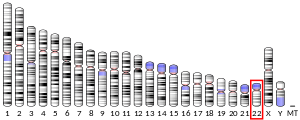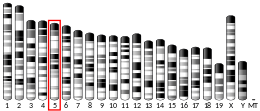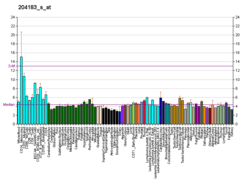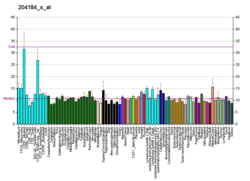G protein-coupled receptor kinase 3
G-protein-coupled receptor kinase 3 (GRK3) is an enzyme that in humans is encoded by the ADRBK2 gene.[5] GRK3 was initially called Beta-adrenergic receptor kinase 2 (βARK-2), and is a member of the G protein-coupled receptor kinase subfamily of the Ser/Thr protein kinases that is most highly similar to GRK2.[6]
Function
G protein-coupled receptor kinases phosphorylate activated G protein-coupled receptors, which promotes the binding of an arrestin protein to the receptor. Arrestin binding to phosphorylated, active receptor prevents receptor stimulation of heterotrimeric G protein transducer proteins, blocking their cellular signaling and resulting in receptor desensitization. Arrestin binding also directs receptors to specific cellular internalization pathways, removing the receptors from the cell surface and also preventing additional activation. Arrestin binding to phosphorylated, active receptor also enables receptor signaling through arrestin partner proteins. Thus the GRK/arrestin system serves as a complex signaling switch for G protein-coupled receptors.[7]
GRK3 and the closely-related GRK2 phosphorylate receptors at sites that encourage arrestin-mediated receptor desensitization, internalization and trafficking rather than arrestin-mediated signaling (in contrast to GRK5 and GRK6, which have the opposite effect).[8][9] This difference is one basis for pharmacological biased agonism (also called functional selectivity), where a drug binding to a receptor may bias that receptor’s signaling toward a particular subset of the actions stimulated by that receptor.[10][11]
GRK3 is expressed broadly in tissues, but generally at lower levels than the related GRK2.[12] GRK3 has particularly high expression in olfactory neurons, and mice lacking the ADRBK2 gene exhibit defects in olfaction.[13][14] Gene linkage techniques were used to identify a polymorphism in the promoter of the human ADRBK2 gene as a possible cause of up to 10% of cases of bipolar disorder.[15] However, the significance of GRK3 in bipolar disorder has been controversial due to conflicting reports.[16] GRK3 has also been implicated in regulation of dopamine receptors in Parkinson’s disease in animal models.[17] Reduced expression of GRK3 has been associated with the immunodeficient WHIM syndrome in humans, and appears causative in a mouse model of the disease.[18][19]
References
- GRCh38: Ensembl release 89: ENSG00000100077 - Ensembl, May 2017
- GRCm38: Ensembl release 89: ENSMUSG00000042249 - Ensembl, May 2017
- "Human PubMed Reference:". National Center for Biotechnology Information, U.S. National Library of Medicine.
- "Mouse PubMed Reference:". National Center for Biotechnology Information, U.S. National Library of Medicine.
- Calabrese G, Sallese M, Stornaiuolo A, Stuppia L, Palka G, De Blasi A (September 1994). "Chromosome mapping of the human arrestin (SAG), beta-arrestin 2 (ARRB2), and beta-adrenergic receptor kinase 2 (ADRBK2) genes". Genomics. 23 (1): 286–8. doi:10.1006/geno.1994.1497. PMID 7695743.
- Benovic JL, Onorato JJ, Arriza JL, Stone WC, Lohse M, Jenkins NA, Gilbert DJ, Copeland NG, Caron MG, Lefkowitz RJ (August 1991). "Cloning, expression, and chromosomal localization of beta-adrenergic receptor kinase 2. A new member of the receptor kinase family". The Journal of Biological Chemistry. 266 (23): 14939–46. PMID 1869533.
- Gurevich VV, Gurevich EV (2019). "GPCR Signaling Regulation: The Role of GRKs and Arrestins". Frontiers in Pharmacology. 10: 125. doi:10.3389/fphar.2019.00125. PMC 6389790. PMID 30837883.
- Kim J, Ahn S, Ren XR, Whalen EJ, Reiter E, Wei H, Lefkowitz RJ (February 2005). "Functional antagonism of different G protein-coupled receptor kinases for beta-arrestin-mediated angiotensin II receptor signaling". Proceedings of the National Academy of Sciences of the United States of America. 102 (5): 1442–7. doi:10.1073/pnas.0409532102. PMC 547874. PMID 15671181.
- Ren XR, Reiter E, Ahn S, Kim J, Chen W, Lefkowitz RJ (February 2005). "Different G protein-coupled receptor kinases govern G protein and beta-arrestin-mediated signaling of V2 vasopressin receptor". Proceedings of the National Academy of Sciences of the United States of America. 102 (5): 1448–53. doi:10.1073/pnas.0409534102. PMC 547876. PMID 15671180.
- Zidar DA, Violin JD, Whalen EJ, Lefkowitz RJ (June 2009). "Selective engagement of G protein coupled receptor kinases (GRKs) encodes distinct functions of biased ligands". Proceedings of the National Academy of Sciences of the United States of America. 106 (24): 9649–54. doi:10.1073/pnas.0904361106. PMC 2689814. PMID 19497875.
- Choi M, Staus DP, Wingler LM, Ahn S, Pani B, Capel WD, Lefkowitz RJ (August 2018). "2-adrenergic receptor". Science Signaling. 11 (544). doi:10.1126/scisignal.aar7084. PMID 30131371.
- Arriza JL, Dawson TM, Simerly RB, Martin LJ, Caron MG, Snyder SH, Lefkowitz RJ (October 1992). "The G-protein-coupled receptor kinases beta ARK1 and beta ARK2 are widely distributed at synapses in rat brain". The Journal of Neuroscience. 12 (10): 4045–55. doi:10.1523/JNEUROSCI.12-10-04045.1992. PMC 6575981. PMID 1403099.
- Boekhoff I, Inglese J, Schleicher S, Koch WJ, Lefkowitz RJ, Breer H (January 1994). "Olfactory desensitization requires membrane targeting of receptor kinase mediated by beta gamma-subunits of heterotrimeric G proteins". The Journal of Biological Chemistry. 269 (1): 37–40. PMID 8276821.
- Ihara S, Touhara K (2018). "G Protein-Coupled Receptor Kinase 3 (GRK3) in Olfaction". Methods in Molecular Biology. 1820: 33–41. doi:10.1007/978-1-4939-8609-5_3. ISBN 978-1-4939-8608-8. PMID 29884935.
- Barrett TB, Hauger RL, Kennedy JL, Sadovnick AD, Remick RA, Keck PE, McElroy SL, Alexander M, Shaw SH, Kelsoe JR (May 2003). "Evidence that a single nucleotide polymorphism in the promoter of the G protein receptor kinase 3 gene is associated with bipolar disorder". Molecular Psychiatry. 8 (5): 546–57. doi:10.1038/sj.mp.4001268. PMID 12808434.
- Luykx JJ, Boks MP, Terwindt AP, Bakker S, Kahn RS, Ophoff RA (June 2010). "The involvement of GSK3beta in bipolar disorder: integrating evidence from multiple types of genetic studies". European Neuropsychopharmacology. 20 (6): 357–68. doi:10.1016/j.euroneuro.2010.02.008. PMID 20226637.
- Ahmed MR, Bychkov E, Li L, Gurevich VV, Gurevich EV (June 2015). "GRK3 suppresses L-DOPA-induced dyskinesia in the rat model of Parkinson's disease via its RGS homology domain". Scientific Reports. 5: 10920. doi:10.1038/srep10920. PMC 4455246. PMID 26043205.
- Balabanian K, Levoye A, Klemm L, Lagane B, Hermine O, Harriague J, Baleux F, Arenzana-Seisdedos F, Bachelerie F (March 2008). "Leukocyte analysis from WHIM syndrome patients reveals a pivotal role for GRK3 in CXCR4 signaling". The Journal of Clinical Investigation. 118 (3): 1074–84. doi:10.1172/JCI33187. PMC 2242619. PMID 18274673.
- Tarrant TK, Billard MJ, Timoshchenko RG, McGinnis MW, Serafin DS, Foreman O, Esserman DA, Chao NJ, Lento WE, Lee DM, Patel D, Siderovski DP (December 2013). "G protein-coupled receptor kinase-3-deficient mice exhibit WHIM syndrome features and attenuated inflammatory responses". Journal of Leukocyte Biology. 94 (6): 1243–51. doi:10.1189/jlb.0213097. PMC 3828605. PMID 23935208.
Further reading
- Benovic JL, Onorato JJ, Arriza JL, Stone WC, Lohse M, Jenkins NA, Gilbert DJ, Copeland NG, Caron MG, Lefkowitz RJ (August 1991). "Cloning, expression, and chromosomal localization of beta-adrenergic receptor kinase 2. A new member of the receptor kinase family". The Journal of Biological Chemistry. 266 (23): 14939–46. PMID 1869533.
- Parruti G, Ambrosini G, Sallese M, De Blasi A (January 1993). "Molecular cloning, functional expression and mRNA analysis of human beta-adrenergic receptor kinase 2". Biochemical and Biophysical Research Communications. 190 (2): 475–81. doi:10.1006/bbrc.1993.1072. PMID 8427589.
- Oppermann M, Freedman NJ, Alexander RW, Lefkowitz RJ (May 1996). "Phosphorylation of the type 1A angiotensin II receptor by G protein-coupled receptor kinases and protein kinase C". The Journal of Biological Chemistry. 271 (22): 13266–72. doi:10.1074/jbc.271.22.13266. PMID 8662816.
- Premont RT, Claing A, Vitale N, Freeman JL, Pitcher JA, Patton WA, Moss J, Vaughan M, Lefkowitz RJ (November 1998). "beta2-Adrenergic receptor regulation by GIT1, a G protein-coupled receptor kinase-associated ADP ribosylation factor GTPase-activating protein". Proceedings of the National Academy of Sciences of the United States of America. 95 (24): 14082–7. doi:10.1073/pnas.95.24.14082. PMC 24330. PMID 9826657.
- Oppermann M, Mack M, Proudfoot AE, Olbrich H (March 1999). "Differential effects of CC chemokines on CC chemokine receptor 5 (CCR5) phosphorylation and identification of phosphorylation sites on the CCR5 carboxyl terminus". The Journal of Biological Chemistry. 274 (13): 8875–85. doi:10.1074/jbc.274.13.8875. PMID 10085131.
- Dunham I, Shimizu N, Roe BA, Chissoe S, Hunt AR, Collins JE, Bruskiewich R, Beare DM, Clamp M, Smink LJ, Ainscough R, Almeida JP, Babbage A, Bagguley C, Bailey J, Barlow K, Bates KN, Beasley O, Bird CP, Blakey S, Bridgeman AM, Buck D, Burgess J, Burrill WD, O'Brien KP (December 1999). "The DNA sequence of human chromosome 22". Nature. 402 (6761): 489–95. doi:10.1038/990031. PMID 10591208.
- Inngjerdingen M, Damaj B, Maghazachi AA (April 2000). "Human NK cells express CC chemokine receptors 4 and 8 and respond to thymus and activation-regulated chemokine, macrophage-derived chemokine, and I-309". Journal of Immunology. 164 (8): 4048–54. doi:10.4049/jimmunol.164.8.4048. PMID 10754297.
- Celver JP, Lowe J, Kovoor A, Gurevich VV, Chavkin C (February 2001). "Threonine 180 is required for G-protein-coupled receptor kinase 3- and beta-arrestin 2-mediated desensitization of the mu-opioid receptor in Xenopus oocytes". The Journal of Biological Chemistry. 276 (7): 4894–900. doi:10.1074/jbc.M007437200. PMID 11060299.
- Blaukat A, Pizard A, Breit A, Wernstedt C, Alhenc-Gelas F, Muller-Esterl W, Dikic I (November 2001). "Determination of bradykinin B2 receptor in vivo phosphorylation sites and their role in receptor function". The Journal of Biological Chemistry. 276 (44): 40431–40. doi:10.1074/jbc.M107024200. PMID 11517230.
- Wang J, Guan E, Roderiquez G, Calvert V, Alvarez R, Norcross MA (December 2001). "Role of tyrosine phosphorylation in ligand-independent sequestration of CXCR4 in human primary monocytes-macrophages". The Journal of Biological Chemistry. 276 (52): 49236–43. doi:10.1074/jbc.M108523200. PMID 11668182.
- Obara K, Arai K, Tomita Y, Hatano A, Takahashi K (October 2001). "G-protein coupled receptor kinase 2 and 3 expression in human detrusor cultured smooth muscle cells". Urological Research. 29 (5): 325–9. doi:10.1007/s002400100207. PMID 11762794.
- Mandyam CD, Thakker DR, Christensen JL, Standifer KM (August 2002). "Orphanin FQ/nociceptin-mediated desensitization of opioid receptor-like 1 receptor and mu opioid receptors involves protein kinase C: a molecular mechanism for heterologous cross-talk". The Journal of Pharmacology and Experimental Therapeutics. 302 (2): 502–9. doi:10.1124/jpet.102.033159. PMID 12130708.
- Barrett TB, Hauger RL, Kennedy JL, Sadovnick AD, Remick RA, Keck PE, McElroy SL, Alexander M, Shaw SH, Kelsoe JR (May 2003). "Evidence that a single nucleotide polymorphism in the promoter of the G protein receptor kinase 3 gene is associated with bipolar disorder". Molecular Psychiatry. 8 (5): 546–57. doi:10.1038/sj.mp.4001268. PMID 12808434.
- Dzimiri N, Muiya P, Andres E, Al-Halees Z (April 2004). "Differential functional expression of human myocardial G protein receptor kinases in left ventricular cardiac diseases". European Journal of Pharmacology. 489 (3): 167–77. doi:10.1016/j.ejphar.2004.03.015. PMID 15087239.
- Teli T, Markovic D, Levine MA, Hillhouse EW, Grammatopoulos DK (February 2005). "Regulation of corticotropin-releasing hormone receptor type 1alpha signaling: structural determinants for G protein-coupled receptor kinase-mediated phosphorylation and agonist-mediated desensitization". Molecular Endocrinology. 19 (2): 474–90. doi:10.1210/me.2004-0275. PMID 15498832.
- Feng YH, Wang L, Wang Q, Li X, Zeng R, Gorodeski GI (June 2005). "ATP stimulates GRK-3 phosphorylation and beta-arrestin-2-dependent internalization of P2X7 receptor". American Journal of Physiology. Cell Physiology. 288 (6): C1342–56. doi:10.1152/ajpcell.00315.2004. PMC 2598767. PMID 15728711.
External links
- Online version of the paper in Molecular Psychiatry
- PubMed abstract
- Report from sciencedaily.com
- Human ADRBK2 genome location and ADRBK2 gene details page in the UCSC Genome Browser.





